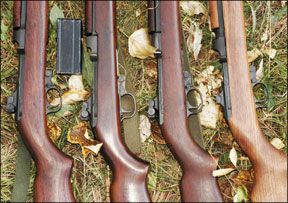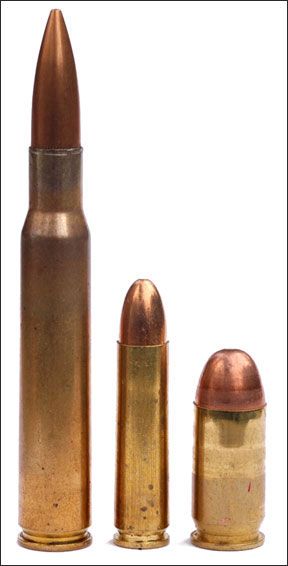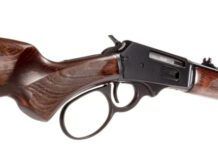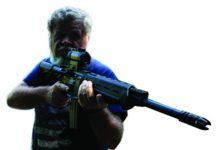The M1 carbine was the most prolific U.S. weapon of the WWII era, with six-odd million made, and it’s still very popular today. It employs an anemic round by rifle standards, but—per its design—its cartridge is at least as powerful as most handgun rounds. Today’s buyer of a genuine WWII-era or Korean War era carbine will probably need to spend around a thousand dollars, give or take a few hundred, for a reasonable example. On GunBroker we saw prices from about $750 to $1400, depending on condition and rarity. However, if you’re qualified, and if you hurry, you may be able to get a decent carbine for about $420-675, through the Civilian Marksmanship Program (CMP) sales. This outlet used to be called the DCM, Director of Civilian Marksmanship, run by the U.S. government, but that program is now in private hands. However, due to the nature of the program, the CMP carbines may be in very short supply by the time this report appears in print.

Do you qualify for a CMP firearm purchase? Taking the CMP requirements straight from the website, “By law, the CMP can sell surplus military firearms, ammunition, parts and other items only to members of CMP-affiliated clubs who are also U.S. citizens, over 18 years of age and… legally eligible to purchase a firearm.” For more information, visit the website.
For this test we acquired four carbines. We had on hand a Fulton Armory carbine, with an original Underwood barrel in near-perfect condition. But if you want a Fulton-built M1 carbine today you’ll have to get it with the new Fulton barrel ($1300). All of the original mil-spec barrels are apparently now gone. Two of our carbines came from the CMP, both “Service Grade.” One was an Underwood (CMP-1, $565) and the other an Inland (CMP-2, $ 495). The so-called “Rack Grade” carbines are a bit less expensive. Finally, we acquired a new Auto-Ordnance AOM130 M1 Carbine ($899) with beautiful walnut stock and newly manufactured metalwork.
In our testing of these four M1 carbines, we found many similarities and a few differences. There were two types of safeties. One was the swinging-arm or “flip” type, which requires pulling a small lever rearward to put the gun into the firing position. This is easily accomplished with the right index finger, by right handers, and fairly easily by the trigger finger of lefties. The second safety type was the crossbolt, similar to that found on many pump shotguns. This required pressing to the left to fire, which we found could not be done as easily by lefties. The Auto-Ordnance and Underwood (CMP-1) carbines had the push-button safety. The Auto-Ord and Underwood also had the flat bolt, and neither of these two had a bayonet lug. All the guns except the Auto-Ord had the stepped, windage-adjustable rear sight. The A-O had a modern-made, two-height sight similar to the original M1 carbine sight, which had to be drifted for windage. The two CMP carbines had a stamped base for the adjustable rear sight. The Fulton had a milled base. The Underwood (CMP-1) had a sheet-metal trigger guard. All had the wing-protected front sight.
We tested with three types of 30 US Carbine FMJ “ball” ammunition, all of it 110-grain loads. It was from Sellier & Bellot, American Eagle, and original U.S. Mil-Spec ball (head stamped LC71). Because the two CMP carbines came without magazines, we used an original Winchester 15-round magazine for all our testing, with one exception explained below.
Generally speaking, here’s what we think. Those who like shooting military type firearms really owe it to themselves to have an M1 carbine. They’re a lot of fun. Good ones need not break the bank, but in an era where the SKS rifles that used to go begging at gun shows for $85 now bring upwards of $400, the price of an M1 carbine is not outlandish, even at the over-a-grand mark. We suggest you act soon, particularly if you want one from the CMP. They’re going fast.
Details on the four guns we tested follow:
Auto-Ordnance AOM130 M1 Carbine 30 US Carbine, $899
The Auto-Ord came in a well-padded box with many little touches to preserve its lovely walnut stock. These included plastic covers on muzzle, bolt handle, and forend swivel. The website indicated a surplus magazine would be supplied. That was not the case here. It came with one new 15-round magazine that had no external military markings. If you want a sling and oiler, they are offered at $26. Neither came with the package.
The website mentioned the carbine was made by Kahr Arms, and the manual that came with it seconded that information. Per the website: “The Auto-Ordnance M1 .30 Caliber carbine is produced in Kahr’s state-of-the-art manufacturing plant in Worcester, MA. The Auto-Ordnance carbines are produced using newly manufactured parts on high-precision computerized machinery. Markings include the following: `Auto-Ordnance, Worcester, MA’ behind the rear sight; `U.S. Carbine, Cal 30 ML’ on the receiver in front of the bolt, and the serial number is engraved on the left side of the receiver.”
Why it says “CAL 30 ML” instead of “CAL. .30 M1” (with the period and decimal point) is best known to Auto-Ordnance and Kahr. We noted the bottom of the new magazine had an extremely poor fit. In fact, the floor plate had been assembled upside down. When we tried to load the magazine, its follower stuck, leaving the rounds loose, with no spring tension. We disassembled the magazine and found lots of gritty dirt inside. On cleaning and replacing the floorplate it still didn’t fit correctly, but we were able to fully load the magazine, and then by pressing the rounds downward we heard the floorplate snap into position. The fit of the new A-O magazine was so poor in the receiver we had to press it hard upward and bump it firmly to engage its lugs. Three mil-spec surplus magazines fit the A-O perfectly. We could barely manage to insert this new magazine into the surplus carbines. It was a poor, tight fit. On testing the A-O’s loaded magazine further, we found a continued tendency for the rounds to stick within the box, thus removing all tension from the spring and rendering the magazine useless.

The Auto-Ordnance had a somewhat sticky bolt, in that it didn’t feel clean at full withdrawal, and we could also hang it up occasionally just before it spun into the locked position. That hang-up disappeared with slight wearing-in of the parts. All the other carbine bolts felt like they were sliding on glass. This one never did have that slick feel. As noted above, the safety was a push-button, like on your pump shotgun. The finish of all the metal parts was very nicely done. Unfortunately, the fit of the bolt caused some immediate wear to the right side of the action, down to bare metal.
On the range we fired three shots with Sellier & Bellot ammunition, and then had a failure to eject the fired case fully, with the outgoing round caught by the slide. This happened with slight variations for the next seven shots in a row. We then tried three rounds of American Eagle and two out of three failed to eject properly. We then tried the new magazine that came with the A-O and as noted above. it would not work properly. Finally we tried the rifle with U.S. Mil-Spec ball for two shots, and neither fired case made it out of the chamber. At that point we nearly gave up on the gun.
We noted what seemed to be more gritty dirt in the A-O’s action, so decided to field-strip it and clean it thoroughly. We did this, but still the rounds failed to extract. On further inspection we found a piece was broken off the front of the extractor. Rather than declare the Auto-Ordnance carbine a failure, we contacted the manufacturer and sent the bolt in for a replacement extractor. Turnaround was extremely fast, and with the new extractor in the rifle we tried our tests again.
We found our repair efforts were well justified. The extractor, which appeared to be an investment-cast part, operated perfectly for the remainder of our limited testing. The little A-O carbine delivered the finest accuracy we’ve encountered from an M1 carbine or clone thereof. With the American Eagle ammo we got five-shot groups as small as 1 inch at 50 yards. There were no more bobbles nor failures to eject.
We were not, however, entirely without complaints. The trigger pull was not what we wanted at all. It was the heaviest of the lot at 7 pounds. We also would have preferred the adjustable rear sight, which we believe most shooters will want also. It’s easier to get your shots where they belong with the fully adjustable one. We found the “low” sight on the AOM130 put the shots about an inch under the point of aim at 50 yards, and a bit to the right. The “high” sight put the shots about a foot higher, too much elevation for casual shooting. We didn’t miss the sling because carbines are easy to carry, but we felt one ought to be included. And of course an oiler would have to be part of that package, since it forms the retention point for the rear of the sling. We liked the light weight and the nice wood, but the operating smoothness was just not as good as it was with the mil-surplus carbines. Finally, the buttplate was plastic. We believe the all-metal one would look better, and please more collectors than the one provided.
Our Team Said: We gave the Auto-Ordnance AOM130 a B- grade for its slightly misfitting and unsmooth bolt that wore the finish so quickly, the very poor magazine, the lack of a sling, and its relatively high cost. Several of our team said they’d spend the extra $400 and get a Fulton Armory carbine over this one.
Fulton Armory Service Grade M1 Carbine30 US Carbine, $1300
The carbine you can buy today from Fulton Armory features all of the attributes of our test rifle but one. Today’s Fulton carbine has a new barrel, made to G.I. specifications by Fulton. All the rest of the parts are genuine G.I., all tested and matched and carefully fitted as the gun is built. There’s a 30-day money-back guarantee if you are dissatisfied in any way. You can add various accessories, including a hand guard with scope mount, extra magazines, bayonet, and many more. Also, Fulton has a full line of M1 carbine parts, if you should need anything to repair your own. Check their website for details.
While $1300 for a carbine will open some eyes and close some pocketbooks, what you get will not require any replacement parts, or retesting, or special fitting, nor will it require a better-grade stock. The bolt will stay open when you push down on the little button, unlike many arsenal-redone carbines. The finish will be crisp, clean newly done Parkerizing, and the whole thing will not only work to perfection, it won’t take a back seat to any carbine, old or new, with the possible exception of some museum specimens. You’re paying for the careful hand fitting done by the folks at Fulton Armory, and you can take that to the bank.
Ours came with a sling, oiler, and a magazine in a heavy, well-padded cardboard box. The flawless walnut stock had a linseed-oil finish. The operation of the weapon was noticeably slicker and crisper than any of the other three carbines. Ours was fitted with the milled rear sight, and a bayonet lug. We’ve noted many collectors like to display the carbine with a bayonet attached. We’ve also commonly seen the two-magazine pouch on the stock. A 30-round magazine inserted into a carbine set up with the bayonet and two spare mags makes an impressive display.
On the range we had exactly no problems with the Fulton. The functioning was perfect, and accuracy was about as good as any of the others. We noted a slight preference for one type of ammo over another with all the carbines, despite its all having the same general specification. To our surprise, the Fulton and one of the CMP carbines did not like the old original Mil-Spec ball ammo at all.
Our Team Said: We could not fault the Fulton, despite its high price. If you are lucky, you might be able to buy a decent rifle from the CMP, or may have to spend a bit more for either a commercial one like the Auto-Ordnance, or for a decent sample from GunBroker or at a gun show, but you’ll never go wrong with the Fulton product. In our experience the company stands by its products, and their products are among the very finest in the business.
CMP-1 Underwood Carbine 30 US Carbine, $565
The Parkerizing was excellent, if not exactly matched throughout this carbine. A slight exception was the buttplate, which showed slight finish wear. The slide on the rear sight was frozen until we oiled it and worked it a bit. The bore appeared to be absolutely pristine. Though we had no way of measuring bore wear at the muzzle, the rifling lands came all the way to the muzzle and appeared sharp. The feel of the bolt was slick, though the bolt would not reliably stay open. The walnut stock was in excellent condition, though it had apparently been refinished at some time. The outline of a cartouche in the right side of the butt stock was evident, but hard to read. The stock had a few slight blemishes, entirely appropriate for a used military weapon, we thought. The sling was new.
After cleaning the barrel and making sure the bolts were tight, we fired for accuracy and function. The trigger, like on all four carbines, was a bit creepy but manageable. It broke at 6.3 pounds. Feed and function were perfect, with five-shot groups averaging just under two inches at 50 yards. Like the Fulton, this one didn’t like the surplus ball ammo, with the worst group approaching 5 inches at 50 yards.
Our Team Said: There were no problems nor any surprises with this Underwood-barreled carbine. We would have preferred a milled trigger guard, but the stamped/welded one was interesting. Overall, we thought it would satisfy anyone short of the most stringent collector.
CMP-2 Inland Carbine 30 US Carbine, $495
We liked this one the best of the two CMP carbines. By a slight amount, it turned in the best accuracy of the test, and it also had the best trigger, breaking creepily just over 5.5 pounds. The walnut stock had fewer dings than the other CMP rifle, largely the luck of the draw, we’re sure. Again the bore looked like a mirror, and the rifling was pretty sharp right out to the crown. The edges of the stock were all quite sharp, and a crossed-cannon cartouche on the right side of the butt stock was still partly visible. The bolt stayed open well, about like that of the Fulton. This one had the flip safety, bayonet lug, and round bolt. The sling was not nearly as new looking as on the other, but was fully serviceable.
There were no surprises, nor failures of any sort. The more we shot the Inland the more we liked it, because it made the best groups of the four carbines. It even shot the old U.S. Ball ammo well, getting groups just over 2 inches. The Parkerizing all seemed to match, except that the bolt was a touch darker. Even the butt plate was in fine condition, with excellent finish. We liked the flip safety and the bayonet lug, which mated well with the adjustable sight. Some slight cleaning of the stock followed by a careful application of linseed oil would bring out the walnut’s grain.
Our Team Said: All told, this was our first choice of all the carbines, especially in light of its lowest price. Although luck plays a part in what you get from the CMP, you could hardly go wrong if you get a carbine like this one, though we note the Inland-barreled versions apparently sold out just yesterday, on the CMP website.
1209-M1-CARBINE-ACCURACY-CHRONO.pdf
1209-CMP-1-UNDERWOOD-CARBINE.pdf




























are the reproduction M1 available in Canada ?